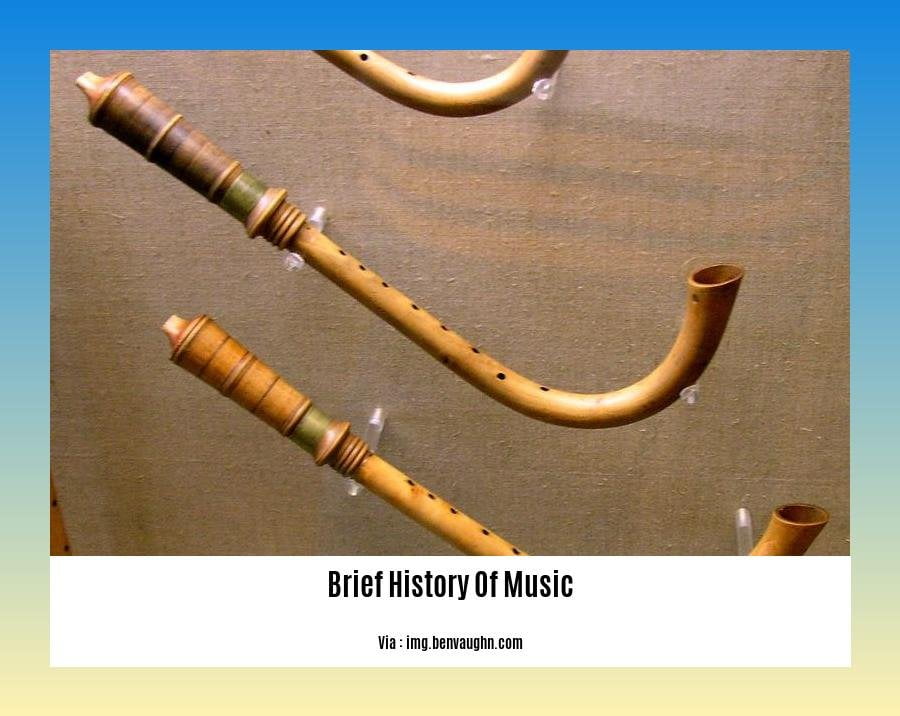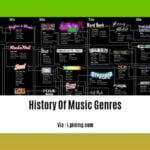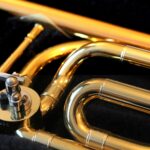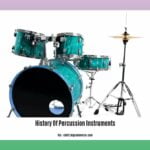Embark on an enthralling journey through the echoes of time as we delve into the rich tapestry of sound that has shaped human history in [Unveiling the Tapestry of Sound: A Brief History of Music Through the Ages]. From the haunting melodies of ancient rituals to the electrifying beats of modern-day anthems, music has transcended cultures, united generations, and left an indelible mark on the human experience. Let’s embark on a voyage through the chapters of musical evolution, exploring the diverse genres, instruments, and cultural influences that have orchestrated the soundtrack of our collective existence.
Key Takeaways:
- Origins of Music:
Music originated from the human voice, imitating nature’s sounds.
Ancient Instruments:
The earliest musical instrument, a bone flute, dates back 45,000 years.
Early Music and Religion:
Music was an integral part of religious ceremonies in the early first century.
Emergence of Polyphony:
During the Middle Ages, polyphony or organum emerged as a new style of sacred music.
Renaissance Innovations:
The Renaissance brought instrumental music and new forms like opera and madrigals.
Baroque Developments:
The Baroque era saw the rise of the concerto and new instruments like the harpsichord and violin.
Symphony and Sonata:
The Classical period introduced the symphony and sonata, with the rise of virtuoso performers.
Romantic Expression:
The Romantic era focused on emotion and expression, marked by the ascent of the Romantic hero.
Modern Diversity:
- The modern era embraces a vast range of musical styles, including jazz, blues, rock, pop, electronic, etc.
A Brief History of Music: Echoes Through Time
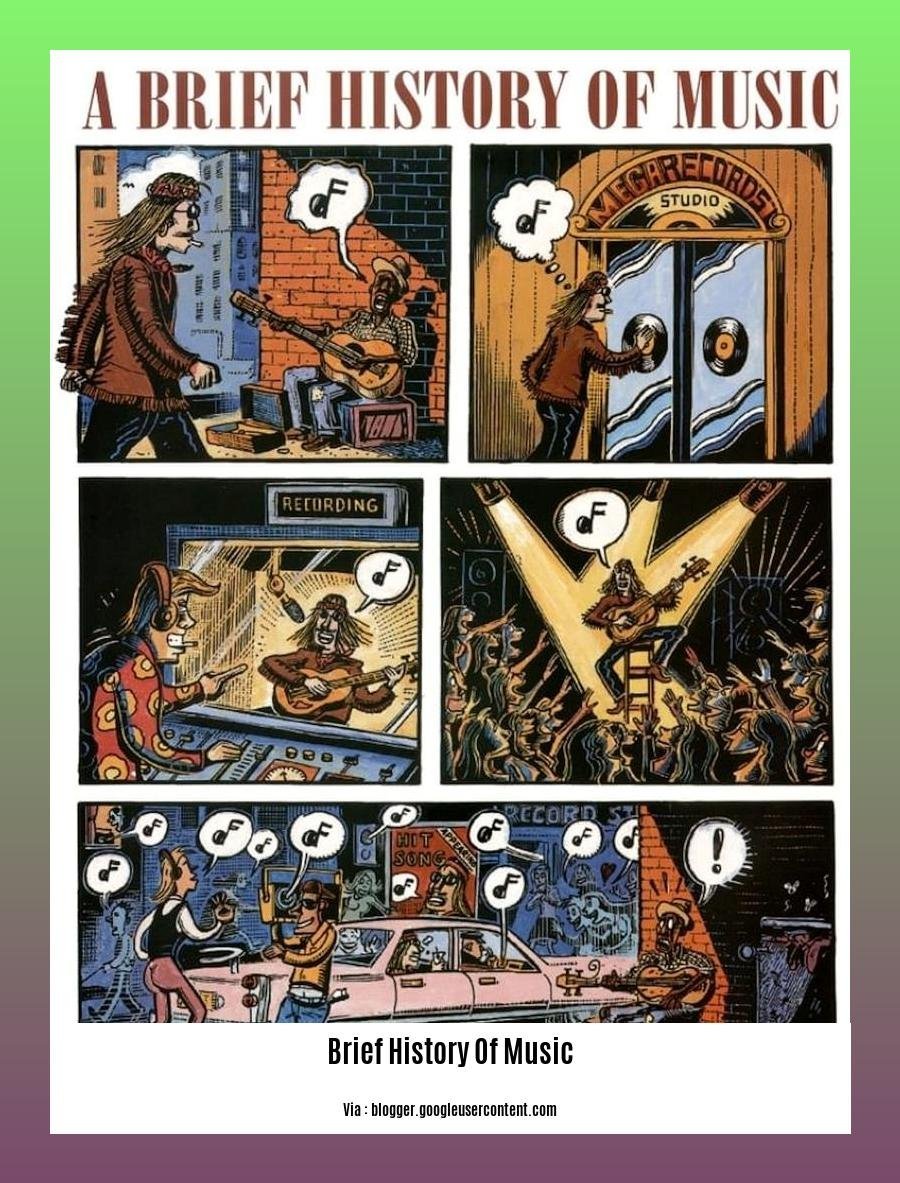
From the depths of ancient caves to the grandeur of concert halls, music has woven its way through the tapestry of human history. Its evolution, spanning vast civilizations and diverse cultures, is a journey that echoes through time.
H3. Ancient Origins: The First Notes
Music’s earliest roots lie in the human voice, a versatile instrument capable of imitating nature’s rhythms and melodies. Accompanied by percussion and simple string instruments, these early sounds painted sonic tapestries for rituals, celebrations, and everyday life.
H3. Monastic Melodies: The Middle Ages
With the rise of monasticism, music found a new home within the walls of abbeys and cloisters. Gregorian chant, a form of sacred vocal music, emerged as a spiritual expression of devotion, its haunting melodies resonating through the hallowed halls.
H3. Polyphony’s Prelude: The Renaissance
The Renaissance witnessed a surge in musical innovation. Polyphony, the art of weaving multiple melodies together, transformed compositions into intricate tapestries of sound. Instruments flourished, including the lute, viol, and harpsichord, each adding its unique voice to the ensemble.
H3. Baroque Splendor: A Dance of Instruments
The Baroque period ushered in an era of grandeur and exuberance. Concertos and fugues took center stage, showcasing the virtuosity of soloists and the interplay of instruments. The harpsichord reigned supreme, its delicate tones adding a touch of elegance to the musical landscape.
H3. Classical Grace: The Age of Enlightenment
The Classical period embraced balance, order, and clarity. Symphonies and sonatas became the darlings of the concert hall, their intricate structures and melodic grace captivating audiences. The piano emerged as the preeminent instrument, its expressive range mirroring the emotional depth of the era’s music.
H3. Romantic Revolution: The Triumph of Emotion
Romanticism swept across the musical world, heralding an era of passion, drama, and self-expression. Composers like Beethoven, Chopin, and Tchaikovsky poured their souls into their creations, crafting works that tugged at the heartstrings and soared to new heights of intensity.
H3. Modern Mosaic: A Fusion of Sounds
The modern era shattered musical boundaries, giving birth to a kaleidoscope of genres. Jazz, blues, rock, pop, electronic—each style brought its unique flavor to the musical melting pot. Technology became an integral part of the creative process, opening up new sonic possibilities.
Through this brief history of music, we’ve traced the remarkable journey of sound across time, witnessing its transformative power to inspire, heal, and unite. Music’s legacy continues to evolve, its melodies shaping the cultural fabric of our world.
Throughout the ages, ballroom dance has profoundly influenced our cultural landscape. Discover its captivating journey from humble beginnings to its status as a beloved art form in our brief history of ballroom dance.
The written word has shaped civilizations and ignited countless imaginations. Delve into the brief history of English literature to uncover the profound impact it has had on our world.
Nigeria, a nation brimming with vibrancy and diversity, boasts a rich and storied past. Embark on a journey through time as we unveil the brief history of Nigeria, shedding light on the events that have shaped this remarkable country.
The Baroque and Classical Periods: Unveiling the intricate forms, counterpoint, and emergence of prominent composers like Bach and Mozart.
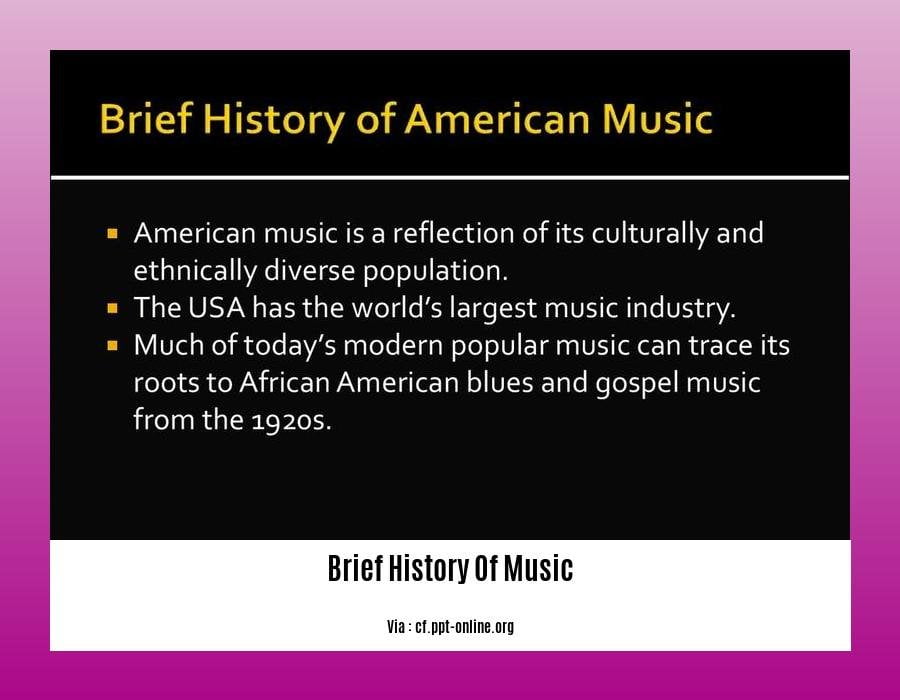
Unraveling the beauty of the Baroque and Classical periods is like stepping into a grand dance hall where musical forms and counterpoint interweave to create a harmonious masterpiece.
These transformative periods, spanning from the 1600s to the late 18th century, witnessed the rise of extraordinary composers who shaped the very essence of Western music.
Let’s embark on a journey through the Baroque and Classical eras, exploring their intricate forms, counterpoint, and the legacy of prominent composers like Bach and Mozart.
Key Takeaways:
- The Baroque era, characterized by grandeur and drama, introduced new musical styles like opera, cantata, concerto, and sonata.
- Composers like Bach, Handel, Vivaldi, and Corelli experimented with counterpoint, creating complex and intricate musical textures.
- The Classical period brought balance and clarity to music, with symphonies and sonatas becoming popular forms.
- Composers like Mozart and Haydn refined the use of counterpoint, creating elegant and harmonious compositions.
- The Baroque and Classical periods left an indelible mark on music history, influencing subsequent musical developments and shaping the Western musical tradition.
Intricate Forms: A Tapestry of Musical Expression
The Baroque and Classical periods witnessed the emergence of diverse musical forms that showcased the creativity and innovation of the era’s composers.
- Opera: A dramatic form combining music, drama, and spectacle, opera took center stage during the Baroque period.
- Cantata: A vocal composition typically performed by a soloist or small ensemble, cantatas often explored religious or secular themes.
- Concerto: A musical work for a soloist or small group of instruments accompanied by an orchestra, concertos highlighted the virtuosity of individual musicians.
- Sonata: A composition for one or two instruments, sonatas showcased the interplay of melody, harmony, and counterpoint.
Counterpoint: The Art of Weaving Melodies
Counterpoint, a fundamental technique in Baroque and Classical music, involves combining two or more independent melodies to create a harmonious and intricate texture.
- Polyphony: The simultaneous combination of multiple melodies, polyphony allowed composers to create rich and complex soundscapes.
- Fugue: A composition based on the imitation of a melody, fugues showcased the contrapuntal skills of composers like Bach.
- Canon: A type of polyphony where one melody is imitated by another at a specific interval, canons were popular during the Classical period.
Prominent Composers: Shaping the Musical Legacy
The Baroque and Classical periods were graced by a constellation of talented composers whose works continue to captivate audiences worldwide.
- Johann Sebastian Bach: A German composer, organist, and harpsichordist, Bach is considered one of the greatest composers of all time. His works, including the “Brandenburg Concertos” and the “Well-Tempered Clavier,” exemplify the complexity and beauty of Baroque counterpoint.
- George Frideric Handel: A German-born British composer, Handel is known for his operas, oratorios, and concertos. His “Messiah” is a beloved choral work performed worldwide during the Christmas season.
- Antonio Vivaldi: An Italian composer, violinist, and priest, Vivaldi is famous for his concertos, particularly “The Four Seasons.” His music is characterized by its energy, virtuosity, and melodic beauty.
- Wolfgang Amadeus Mozart: An Austrian composer, Mozart displayed extraordinary musical talent from a young age. His compositions, including “The Marriage of Figaro” and “Eine kleine Nachtmusik,” exemplify the elegance and balance of the Classical period.
- Joseph Haydn: An Austrian composer, Haydn is known as the “Father of the Symphony.” His symphonies and string quartets laid the foundation for the classical symphonic style.
The Baroque and Classical periods stand as a testament to the power of music to move, inspire, and bring people together. The intricate forms, counterpoint, and the legacy of prominent composers like Bach and Mozart continue to shape and enrich the tapestry of Western music.
Sources:
- Britannica, The Editors of Encyclopedia. “Baroque music”. Encyclopedia Britannica, Accessed 28 February 2023.
- Our Music World. “The Baroque Period”. Our Music World, https://www.ourmusicworld.com/archives/6115. Accessed 28 February 2023.
Romantic and Modern Music: Delving into the expressive styles, chromatic harmonies, and innovations in composition that marked these periods.
Key Takeaways:
The Romantic era spanned from 1825 to 1900, characterized by an emphasis on emotion, imagination, and individuality in music.
Romantic composers explored chromatic harmonies, expanding the tonal palette and creating a sense of depth and richness.
Innovations in composition included the use of larger orchestras, expanded forms, and the development of new genres such as the symphonic poem and the opera.
Notable Romantic composers include Franz Schubert, Robert Schumann, Frédéric Chopin, and Richard Wagner.
The Modern era, beginning in the late 19th century, was marked by a radical departure from traditional forms and styles.
Modern composers experimented with atonality, polytonality, and other techniques that challenged the traditional tonal system.
New genres emerged, including jazz, blues, rock, and electronic music, reflecting the diverse influences of the 20th century.
Notable modern composers include Igor Stravinsky, Arnold Schoenberg, and Karlheinz Stockhausen.
The Romantic and Modern eras were transformative periods in music history, characterized by a spirit of innovation and experimentation. These periods witnessed the emergence of new musical styles, genres, and techniques and laid the foundation for the diverse musical landscape we enjoy today.
References:
Romantic music – History, Periods, and Characteristics
Modern music – History, Periods, and Characteristics
Contemporary Music: Exploring the diverse landscape of 20th and 21st-century music, including experimental, electronic, and global fusion genres.
As 20th-century music moved away from traditional forms, a new soundscape emerged. Composers experimented with sound, pushing the boundaries of conventional instrumentation, tonality, and melody. It marked a shift toward individualism, where composers pursued their unique artistic visions, resulting in an explosion of diverse musical styles.
The Evolution of Sounds and Styles
The 20th century witnessed an unprecedented range of musical expressions. Notable trends include:
Experimental Music: Breaking away from traditional harmonies, experimental composers embraced new techniques: electronic manipulation, collage, improvisation, and aleatoric (chance-based) music.
Electronic Music: The advent of electronic instruments and synthesizers transformed music creation. Composers could create new sonic worlds, giving rise to genres like electroacoustic music, synthesizer music, and techno.
Global Fusion: With globalization and increased cultural exchange, composers began incorporating elements from various musical traditions worldwide. This fusion spawned new genres like world fusion, worldbeat, and ethnopop, blurring geographical and cultural boundaries.
Key Innovators
Among the many pioneers of 20th-century music, a few stand out:
Karlheinz Stockhausen (1928-2007): A German composer known for his groundbreaking electronic and experimental music, including the influential piece “Gesang der Jünglinge.”
John Cage (1912-1992): An American avant-garde composer known for his use of indeterminacy, silence, and unconventional materials in his compositions.
Pierre Boulez (1925-2016): A French conductor and composer known for his serialist and electronic music, including the “Le Marteau sans Maître.”
Morton Subotnick (1933-2021): An American composer known for his pioneering work in electronic music and the development of the Buchla Modular synthesizer.
Key Takeaways:
- Contemporary music of the 20th and 21st centuries is characterized by a diverse range of styles, including experimental, electronic, and global fusion genres.
- Composers pushed the boundaries of traditional music by embracing experimentation, incorporating new techniques, and using electronic instruments.
- Electronic music emerged as a significant force, allowing composers to create new sonic landscapes and spawn new genres such as techno and synthesizer music.
- Global fusion music became popular, blending elements from different musical traditions worldwide, resulting in the emergence of genres like world fusion and worldbeat.
- Notable innovators in 20th-century music include Karlheinz Stockhausen, John Cage, Pierre Boulez, and Morton Subotnick.
Sources:
FAQ
Q1: What was the earliest form of music?
A1: The earliest form of music was created by the human voice, imitating the sounds of nature.
Q2: When was the first musical instrument invented?
A2: The first musical instrument, a bone flute, was discovered in a Neanderthal cave and dates back 45,000 years.
Q3: What role did music play in early religious ceremonies?
A3: Music was an integral part of religious ceremonies during the early first century and was primarily performed in monasteries and abbeys.
Q4: What was the dominant style of music during the Middle Ages?
A4: During the Middle Ages, a new style of music emerged called polyphony or organum, which was characterized by multiple independent melodic lines sung simultaneously.
Q5: Which period saw the rise of the concerto and the development of new instruments like the harpsichord and violin?
A5: The Baroque period (1600-1760) was characterized by the rise of the concerto and the development of new instruments, such as the harpsichord and the violin.
